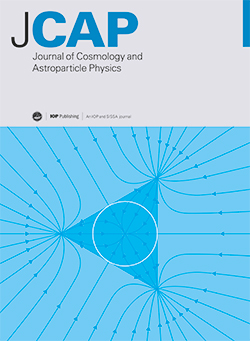Cosmic neutrino decoupling and its observable imprints: insights from entropic-dual transport
IF 5.3
2区 物理与天体物理
Q1 ASTRONOMY & ASTROPHYSICS
Journal of Cosmology and Astroparticle Physics
Pub Date : 2024-09-04
DOI:10.1088/1475-7516/2024/09/014
引用次数: 0
Abstract
Very different processes characterize the decoupling of neutrinos to form the cosmic neutrino background (CνB) and the much later decoupling of photons from thermal equilibrium to form the cosmic microwave background (CMB). The CνB emerges from the fuzzy, energy-dependent neutrinosphere and encodes the physics operating in the early universe in the temperature rangeT ∼ 10 MeV to T ∼ 10 keV. This is the epoch where beyond Standard Model (BSM) physics, especially in the neutrino sector, may be influential in setting the light element abundances, the necessarily distorted fossil neutrino energy spectra, and other light particle energy density contributions. Here we use techniques honed in extensive CMB studies to analyze the CνB as calculated in detailed neutrino energy transport and nuclear reaction simulations of the protracted weak decoupling and primordial nucleosynthesis epochs. Our moment method, relative entropy, and differential visibility approach can leverage future high precision CMB and light element primordial abundance measurements to provide new insights into the CνB and any BSM physics it encodes. We demonstrate that the evolution of the energy spectrum of the CνB throughout the weak decoupling epoch is accurately captured in the Standard Model by only three parameters per species, a non-trivial conclusion given the deviation from thermal equilibrium and the impact of the decrease of electron-positron pairs. Furthermore, we can interpret each of the three parameters as physical characteristics of a non-equilibrium system. Though the treatment presented here makes some simplifying assumptions including ignoring neutrino flavor oscillations, the success of our compact description within the Standard Model motivates its use also in BSM scenarios. We further demonstrate how observations of primordial light element abundances can be used to place constraints on the CνB energy spectrum, deriving response functions that can be applied for general deviations from a thermal spectrum. Combined with the description of those deviations that we develop here, our methods provide a convenient and powerful framework to constrain the impact of BSM physics on the CνB.宇宙中微子解耦及其可观测印记:熵双输运的启示
中微子脱钩形成宇宙中微子背景(CνB)和光子脱钩形成宇宙微波背景(CMB)的过程特征截然不同。CνB 来自模糊的、与能量有关的中微子层,编码了早期宇宙在 T ∼ 10 MeV 到 T ∼ 10 keV 温度范围内运行的物理学。这是超越标准模型(BSM)物理学,尤其是中微子领域的物理学可能对确定轻元素丰度、必然扭曲的化石中微子能量谱以及其他轻粒子能量密度贡献产生影响的时代。在这里,我们利用在广泛的 CMB 研究中磨练出来的技术,分析了在旷日持久的弱脱钩和原始核合成时代的详细中微子能量传输和核反应模拟中计算出的 CνB。我们的矩法、相对熵和差分能见度方法可以利用未来的高精度 CMB 和轻元素原始丰度测量,为 CνB 及其编码的任何 BSM 物理提供新的见解。我们证明,在整个弱解耦纪元中,标准模型只用每个物种的三个参数就能准确捕捉到CνB能谱的演变,考虑到热平衡的偏离和电子-正电子对减少的影响,这是一个非同小可的结论。此外,我们还可以把这三个参数中的每一个解释为非平衡系统的物理特征。虽然本文的处理方法做了一些简化假设,包括忽略了中微子的味道振荡,但我们在标准模型中的紧凑描述取得了成功,这促使我们也将其用于 BSM 情景中。我们进一步展示了如何利用对原始轻元素丰度的观测来对 CνB 能谱施加约束,并推导出响应函数,可用于热谱的一般偏差。结合我们在这里对这些偏差的描述,我们的方法为约束 BSM 物理对 CνB 的影响提供了一个方便而强大的框架。
本文章由计算机程序翻译,如有差异,请以英文原文为准。
求助全文
约1分钟内获得全文
求助全文
来源期刊

Journal of Cosmology and Astroparticle Physics
地学天文-天文与天体物理
CiteScore
10.20
自引率
23.40%
发文量
632
审稿时长
1 months
期刊介绍:
Journal of Cosmology and Astroparticle Physics (JCAP) encompasses theoretical, observational and experimental areas as well as computation and simulation. The journal covers the latest developments in the theory of all fundamental interactions and their cosmological implications (e.g. M-theory and cosmology, brane cosmology). JCAP''s coverage also includes topics such as formation, dynamics and clustering of galaxies, pre-galactic star formation, x-ray astronomy, radio astronomy, gravitational lensing, active galactic nuclei, intergalactic and interstellar matter.
文献相关原料
| 公司名称 | 产品信息 | 采购帮参考价格 |
|---|
 求助内容:
求助内容: 应助结果提醒方式:
应助结果提醒方式:


